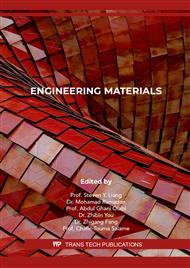[1]
L'Hocine L.H" Yahia, Shape memory polymer for biomedical application,, Elsevier LTd. All rights reserved, (2015).
Google Scholar
[2]
M.J. Mahmoodi, M.K. Hassanzade –Aghdam and Ansari. Effects of added SIO2 nanoparticles on the thermal expansion behavior of shape memory polymer, 30(1), (2014): 32-44.
Google Scholar
[3]
Guoqiang Li, Self- Healing composites: Shape memory –Polymer – Based structures,, John wiley and sons LTd. (2015).
Google Scholar
[4]
David L.Safran Ski and Jack C. Griffis Shape –memory polymer Device Design,,(2017) Elsevier Inc.
Google Scholar
[5]
Guoqiang and Wei Xu, Thermo mechanical behavior of thermoset shape memory polymer programmed by cold- compression: Testing and constitutive modeling, Journal of the mechanics and physics of solid, 59, (2011): 1231-1250.
DOI: 10.1016/j.jmps.2011.03.001
Google Scholar
[6]
Rola Abbas and M.Al-maamori, Design and performance Evaluation of the Shape memory characterization machine for (SMPs),, American Institute of physics (APC), to be Published.
Google Scholar
[7]
Martin Bothe, Shape Memory and Actuation Behavior of Semicrystalline Polymer Networks,, thesis submit led to fulfill the requirement for the degree of Doctor of philosophy (PhD) in mechanics, University at Berlin, (2014).
Google Scholar
[8]
Andreas Lendlein and S.Kelch, Shape - memory polymer,, Angew. Chem. Int. Ed., 41, (2002): 2034-2057.
DOI: 10.1002/1521-3773(20020617)41:12<2034::aid-anie2034>3.0.co;2-m
Google Scholar
[9]
H. A. Khonakdar, Seyed H J, and Sorour R, Jalil M, Hossein A. Investigation and Modeling of Temperature Dependence Recovery Behavior of Shape-Memory Crosslinked Polyethylene,, Macromolecular Journal, 16, (2007): 43-52.
DOI: 10.1002/mats.200600041
Google Scholar
[10]
Guoqiang Li, Anqi Wang, Cold, warm, and hot programming of shape memory polymers ,, Journal of Polymer Science Physics, 54, (2016): 1319-1339.
DOI: 10.1002/polb.24041
Google Scholar
[11]
Meng. H, Li G, A Review of Stimuli-responsive Shape Memory Polymer Composites,, United Kingdom, 54, (2013): 2199-2221.
DOI: 10.1016/j.polymer.2013.02.023
Google Scholar
[12]
F. Castro, K. K. Westbrook, J. Hermiller, D. U. Ahn, Y. Ding, H. J. Qi,Time Dependent Recovery of Shape Memory Polymers,, Conference Proceedings of the Society for Experimental Mechanics Series book series 15, 3, (2011): 307-312.DOI 10.1007/978-1-4419-9794-4_42.
DOI: 10.1007/978-1-4419-9794-4_42
Google Scholar
[13]
Kai Yu, Qi Ge and H. Jerry Qi,Reduced time as a unified parameter determining fixity and free recovery of shape memory polymers,. Nature communications, (2014): 1-9.
DOI: 10.1038/ncomms4066
Google Scholar
[14]
Vanessa A. Fernandes, Davide S.A.De Focatiis, The role of deformation history on stress relaxation and stress memory of filled rubber,, Polymer Testing 40, (2014): 124-132.
DOI: 10.1016/j.polymertesting.2014.08.018
Google Scholar
[15]
Frank K, Joerg C. Tiller,Shape memory natural rubber,, Journal of Polymer Science Part B: Polymer Physics, 54(14), (2016): 1381-1388.
DOI: 10.1002/polb.24040
Google Scholar
[16]
R. Abishera, R. Velmurugan, K. V. Nagendra Gopal, Shape memory behavior of cold-programmed carbon fiber reinforced CNT/epoxy composites,. Materials Research Express, 5(8), (2018): 1-19.
DOI: 10.1088/2053-1591/aaa60c
Google Scholar
[17]
Ming Lei, Zhen Chen, Haibao Lu and Kai Yu, Recent progress in shape memory polymer composites: methods, properties, applications and prospects,, Journal Nanotechnology Reviews; 8(1), (2019): 327–351.
DOI: 10.1515/ntrev-2019-0031
Google Scholar
[18]
Avraham .I. B, Irina. G, Asaf. B, Noam E, and Ronen V, The Effect of POSS Type on the Shape Memory Properties of Epoxy-Based Nanocomposites,. Journal Molecules, 25(18), (2020): 1-19.
Google Scholar
[19]
Ingrid A. Rousseau, and Tao Xie, Shape memory epoxy: Composition, structure, properties and shape memory performances,, J. Mater. Chem, 20(17), (2010): 3431–3441.
DOI: 10.1039/b923394f
Google Scholar
[20]
Jiquan Li , Yadong Jia, Taidong Li, Zhou Zhu, Hangchao Zhou, Xiang Peng, and Shaofei Jiang, Tensile Behavior of Acrylonitrile Butadiene Styrene at Different Temperatures,, Hindawi: Advances in Polymer Technology, 2020,(2020):Article ID 8946591, 10 pages.
DOI: 10.1155/2020/8946591
Google Scholar
[21]
B. Heuwers, A. Beckel, A. Krieger, F. Katzenberg, J. C. Tiller, Shape-Memory Natural Rubber: An Exceptional Material for Strain and Energy Storage, Macromolecular Chemistry and Physics, 214, (2013): 912−923.
DOI: 10.1002/macp.201200649
Google Scholar
[22]
Bever, de, J. J. M. Dynamic behaviour of rubber and rubber like materials, Technische Universiteit Eindhoven, literature survey. (DCT rapporten; 6,(1992): 1-71.
Google Scholar
[23]
N M Setyadewi, N. Indrajati and N. Darmawan, Mechanical properties and curing characteristics of shape memory natural rubber,, IOP Conference Series: Materials Science and Engineering, 541 (2019): 012012(1-6).
DOI: 10.1088/1757-899x/541/1/012012
Google Scholar
[24]
J. Ciambella, A. Paolone and S. Vidoli, Memory decay rates of viscoelastic solids: not too slow, but not too fast either,. J.Rheologica Acta, 50, (2011): 661–674.
DOI: 10.1007/s00397-011-0549-y
Google Scholar
[25]
A.Favata, P. Podio-Guidugli and G. Tomassetti, Energy Splitting Theorems for Materials with Memory,, Journal of Elasticity, 101,(2010): 59–67.
DOI: 10.1007/s10659-010-9244-y
Google Scholar
[26]
D. Drozdov1 and N. Dusunceli. Mullins-type phenomena in polypropylene,, Int. J. of Appl. Math. and Mech,8(11)(2012): 82-98.
Google Scholar
[27]
par Xavier Morelle, Mechanical characterization and physics based modeling of highly-crosslinked epoxy resin, thesis for the degree of doctor philosophy (PhD) in mechanics , Universite catholique de Louvain (UCL), Institute of Mechanics, (2015).
Google Scholar
[28]
V. Izraylit, M. Heuche, O. E.C. Gould, K. Kratz, A. Lendlein, Strain recovery and stress relaxation behaviour of multiblock copolymer blends physically cross-linked with PLA stereocomplexation,, J. Polymer, 209, (2020): 122984.
DOI: 10.1016/j.polymer.2020.122984
Google Scholar


